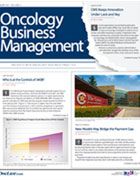A Change of Horses in Midstream
The Affordable Care Act has given rise to healthcare upon which many now depend. Those with an ear to the tracks in Washington, DC, believe that something new is definitely on the way.
OncLive Chairman,
Mike Hennessy
The Affordable Care Act (ACA) has given rise to healthcare upon which many now depend. Now there is talk of repeal and replacement. Those with an ear to the tracks in Washington, DC, believe that something new is definitely on the way. What that might be still is anybody’s guess.
In the sphere of oncology, many are concerned about the potential for interim upheaval, as our cover story on page 10 explains. The number of Americans without coverage could grow depending on what happens. Many practices have Medicare patients and patients with good employer coverage, and so effects from a less-than-desirable replacement to the ACA would be minimal. But many other practices, particularly in the South, serve Medicaid and health exchange populations, which could lose coverage by repeal. Also, changes to laws affecting coverage for preexisting conditions, lifetime caps on coverage, and maximum out-of-pocket expense could have a huge effect on access to care. Oncologists said these are some of their biggest concerns.
This month’s issue includes a Big Data feature. The question for the healthcare industryis how to put Big Data and cancer treatment together successfully in order to provide good, solid guidance for employers on which healthcare plans to o er their employees? Nobody has the answer yet. As our story makes clear, there are many obstacles to be overcome.
Emerging data analytics companies have set out to learn how they can exploit regional differences among employee groups to save employers and employees money in their choice of healthcare plans. The task is given added complexity by the variability of cancers and treatment costs, and of patient care differences and care needs. In addition, the availability of medical claims information is often blocked by patient privacy concerns.
With the available information, data analytics companies have already discovered that employee health needs can be forecast based on prior claims. It is also possible to choose money-saving prescription plans that reflect the needs of specific employee populations. Aaron Huang, vice president of marketing at Lumity in San Mateo, CA, is hopeful that, in the future, Lumity’s data analytics capability can be paired with patient navigation to yield large savings in cancer care. Due to the breadth of medical attention and huge expense associated with long-term cancer care, Huang believes there is a level of waste that reaches or exceeds 20%. All of that is fodder for the evolving algorithms of Big Data.
In modern practice, it has become clear that you need other sets of algorithms, too. When patients experience treatment-related problems after hours, you have to be able to steer them in the proper direction. This is increasingly referred to as phone triage—which we write about this month on page 6.
John Sprandio, MD, of Consultants in Medical Oncology and Hematology, explained that since 1988, the phone triage algorithms at his three Philadelphia-area practices have been revised many times. But at least two fundamental lessons have come from the experience: there is value in uniformity of procedure, meaning that physicians need to agree to follow protocol; and second, perfection in phone triage doesn’t come immediately. There is endless refinement. Read about what he and others have to say on this subject.
Finally, a few words of praise and gratitude for those of you who have contributed written material to the magazine. We welcome your contributions and encourage others to share their voices as well. Oncology Business ManagementTM is your window into what’s happening in the oncology sector, and your insights clarify that picture for all.




